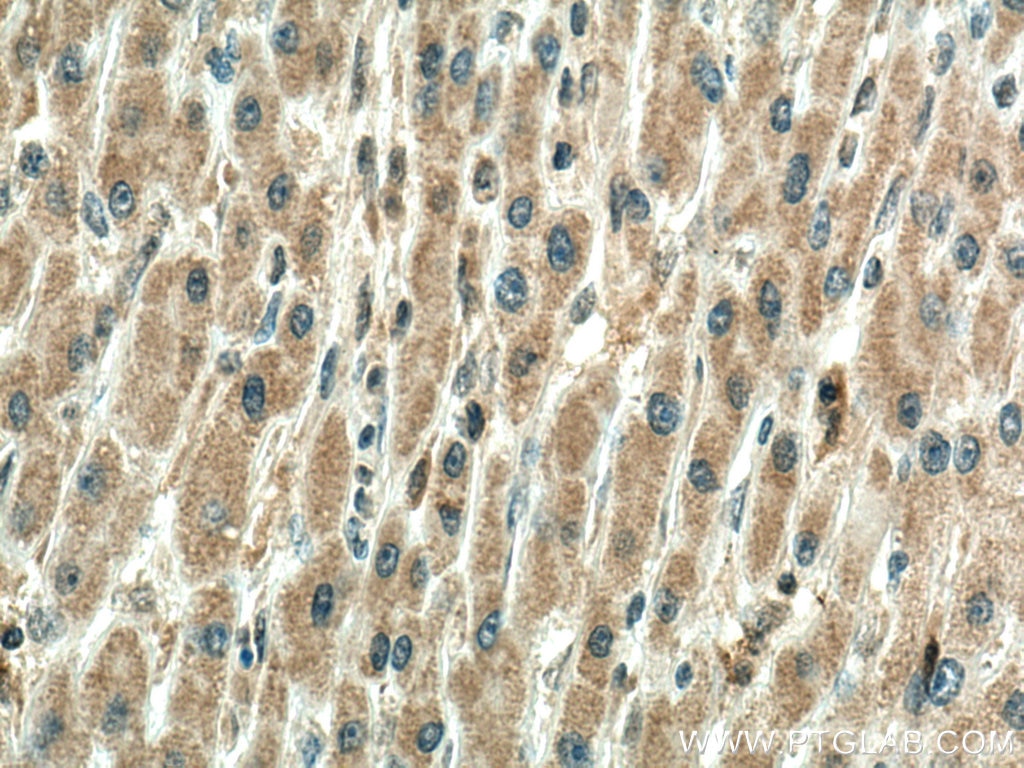- Phare
- Validé par KD/KO
Anticorps Monoclonal anti-TXNRD1
TXNRD1 Monoclonal Antibody for WB, IHC, IF/ICC, ELISA
Hôte / Isotype
Mouse / IgG1
Réactivité testée
Humain, rat, souris et plus (1)
Applications
WB, IHC, IF/ICC, ELISA
Conjugaison
Non conjugué
CloneNo.
1B10C4
N° de cat : 67728-1-Ig
Synonymes
Galerie de données de validation
Applications testées
| Résultats positifs en WB | cellules HSC-T6, cellules 4T1, cellules A549, cellules HEK-293, cellules HeLa, cellules Jurkat, cellules K-562, cellules NIH/3T3, cellules PC-12 |
| Résultats positifs en IHC | tissu de cancer du foie humain, il est suggéré de démasquer l'antigène avec un tampon de TE buffer pH 9.0; (*) À défaut, 'le démasquage de l'antigène peut être 'effectué avec un tampon citrate pH 6,0. |
| Résultats positifs en IF/ICC | cellules HeLa, |
Dilution recommandée
| Application | Dilution |
|---|---|
| Western Blot (WB) | WB : 1:5000-1:50000 |
| Immunohistochimie (IHC) | IHC : 1:500-1:2000 |
| Immunofluorescence (IF)/ICC | IF/ICC : 1:200-1:800 |
| It is recommended that this reagent should be titrated in each testing system to obtain optimal results. | |
| Sample-dependent, check data in validation data gallery | |
Applications publiées
| KD/KO | See 1 publications below |
| WB | See 14 publications below |
| IF | See 2 publications below |
Informations sur le produit
67728-1-Ig cible TXNRD1 dans les applications de WB, IHC, IF/ICC, ELISA et montre une réactivité avec des échantillons Humain, rat, souris
| Réactivité | Humain, rat, souris |
| Réactivité citée | Humain, poulet, souris |
| Hôte / Isotype | Mouse / IgG1 |
| Clonalité | Monoclonal |
| Type | Anticorps |
| Immunogène | TXNRD1 Protéine recombinante Ag30071 |
| Nom complet | thioredoxin reductase 1 |
| Masse moléculaire calculée | 55 kDa |
| Poids moléculaire observé | 50-70 kDa |
| Numéro d’acquisition GenBank | BC018122 |
| Symbole du gène | TXNRD1 |
| Identification du gène (NCBI) | 7296 |
| Conjugaison | Non conjugué |
| Forme | Liquide |
| Méthode de purification | Purification par protéine G |
| Tampon de stockage | PBS with 0.02% sodium azide and 50% glycerol |
| Conditions de stockage | Stocker à -20°C. Stable pendant un an après l'expédition. L'aliquotage n'est pas nécessaire pour le stockage à -20oC Les 20ul contiennent 0,1% de BSA. |
Informations générales
Thioredoxin reductase-1 (TXNRD1) is uniquely capable of utilizing electrons from NADPH to recover the reduced state of TRX1. Interestingly, TXNRD1 is upregulated in many human malignancies and promotes cancer progression, and attenuation of TXNRD1 levels effectively suppresses the growth of tumor cells (PMID: 31384178). TXNRD1 is also upregulated in many human malignancies and functions as a prognostic factor for many tumors, such as oral squamous cell carcinomas, lung cancer, breast cancer, and astrocytomas. TXNRD1 protein levels were analyzed by inmmunoblotting. Bands of ~55 kDa for TXNRD1 were observed. IHC analysis suggested TXNRD1 was mainly located in the cytoplasm. (PMID: 28536696, PMID: 20584310)
Protocole
| Product Specific Protocols | |
|---|---|
| WB protocol for TXNRD1 antibody 67728-1-Ig | Download protocol |
| IHC protocol for TXNRD1 antibody 67728-1-Ig | Download protocol |
| IF protocol for TXNRD1 antibody 67728-1-Ig | Download protocol |
| Standard Protocols | |
|---|---|
| Click here to view our Standard Protocols |
Publications
| Species | Application | Title |
|---|---|---|
Adv Sci (Weinh) Identification of PRDX5 as A Target for The Treatment of Castration-Resistant Prostate Cancer | ||
Redox Biol Guiding bar motif of thioredoxin reductase 1 modulates enzymatic activity and inhibitor binding by communicating with the co-factor FAD and regulating the flexible C-terminal redox motif | ||
Redox Biol Mecheliolide elicits ROS-mediated ERS driven immunogenic cell death in hepatocellular carcinoma. | ||
J Immunother Cancer Nanoparticle delivery of miR-21-3p sensitizes melanoma to anti-PD-1 immunotherapy by promoting ferroptosis. | ||
Front Oncol A Robust Metabolic Enzyme-Based Prognostic Signature for Head and Neck Squamous Cell Carcinoma.
| ||
Front Oncol Bioinformatics-Driven Identification of p62 as A Crucial Oncogene in Liver Cancer. |






